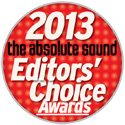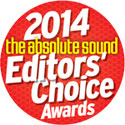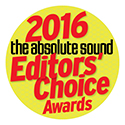Written by Robert Harley - Editor in Chief of The Absolute Sound!
Packed with Expert Advice on the Latest in Cutting-Edge Audio Equipment! The "Bible" for High-End Audio!







Before you make a mistake, buy Bob Harleys book. Sam Tellig, Stereophile
In this newly revised and updated fifth edition, Robert Harley, editor in chief of the Absolute Sound magazine, tells you everything you need to know about buying and enjoying high-quality hi-fi. With this book, discover how to get the best sound for your money, how to identify the weak links in your system and upgrade where it will do the most good, how to set up and tweak your system for maximum performance, and how to become a more perceptive and appreciative listener. Just a few of the secrets you will learn cover high-end sound on a budget, how to do it cheap and still do it right; five system set-up mistakes and how to avoid them; how to make your speakers sound up to 50% better, at no cost; how to choose and set up a computer-based music system; how to find the one speaker in 50 worth owning; and why all 100-watt amplifiers don't sound the same. Since the first edition's publication in 1994, The Complete Guide to High-End Audio has been considered the essential reference on high-quality music reproduction, with more than 150,000 copies sold in five languages.
The Latest Information
Completely revised and updated with the latest information on high-resolution digital audio, music servers, computer-based audio, downloadable music, Blu-ray Disc, new advances in loudspeaker technology, the vinyl revolution, and more. Also includes an entirely new chapter packed with insider secrets on setting up an audio system for maximum performance.
A Friendlier-Than-Ever Voice
More than a consumer guide, this book is a celebration of high-quality music reproduction in the home. Its unique blend of the technical with the aesthetic shows you how to enjoy music with a newfound depth and passion.
And What a Track Record!
The world's best-selling book on high-performance audio
More than 100,000 copies sold in four languages
Critically acclaimed worldwide as the essential reference on high-quality music reproduction
These are just a few of the secrets you will learn:
High-end sound on a budget; how to do it cheap and still do it right
Five system set-up mistakes and how to avoid them
How to make your speakers sound up to 50% better - at no cost
How to get true high-end sound from you iPod
How to join the high-resolution digital revolution
How to find the one speaker in 50 worth owning
Why all "100W" amplifiers don't sound the same
"Its impressive breadth and depth make it a valuable guide to audio's gold mine... You'll learn valuable things from harley's book, not just at first reading, but as you come back to it over and over." - Peter Moncrieff, International Audio Review
A monthly magazine like Stereophile often devotes space to introductory articles, buying tips, or features on systems and listening rooms; but it could never put together the material in such a structured and consistent way as Robert Harley has achieved in The Complete Guide to High-End Audio... I can firmly recommend this unique, largely up-to-date book. Martin Colloms, Stereophile
This is one valuable book, rich in information and insight into the world of high-end audio. I have benefitted immensely from this book and I believe it to be the bible for high-end audio. Dennis Krishnan, High-End Magazine
Robert Harley is the editor in chief of The Absolute Sound, the world's most respected magazine on high-performance audio. He is the author of Introductory Guide to High-Performance Audio Systems and Home Theater for Everyone and has written more than 1,000 product reviews and articles on high-quality music reproduction.
Features:
7" x 10" Book
556 Total Pages
Softcover
Fifth Edition
Written by Robert Harley
Contents:
Foreword
Preface
About the Author
Part One:
What is High-End Audio?
Part Two:
Choosing a High-End Audio System
A. Introduction
B. Choosing the System Best Suited to Your Needs
C. Setting Your Budget
D. The Complete vs. the Incremental Purchase
1. Value vs. Luxury Compoents
E. Allocating Your Budget to Specific Components
F. Upgrading a Single Component
G. How to Read Magazine Reviews
H. System Matching
I. Do's and Don'ts of Selecting Components
J. Your Relationship with the Retailer
K. Used Equipment
L. Product Upgrades
M. Component Selection Summary
Part Three:
Becoming a Better Listener
A. Audiophile Values
B. Pitfalls of Becoming a Critical Listener
C. Sonic Descriptions and their Meanings
1. Tonal Balance
2. Overall Perspective
3. The Treble
4. The Midrange
5. The Bass
6. Soundstaging
7. Dynamics
8. Detail
9. Pace, Rhythm, and Timing
10. Coherence
11. Musicality
12. Notes on Learning Descriptive Terms
D. Critical Listening Setup Procedures
E. Single-Presentation Listening - What It's All About
F. Critical Listening Summary
G. Level Matching
Part Four:
Preamplifiers
A. Introduction
B. How to Choose a Preamplifier
1. Balanced and Unbalanced Connections
2. Other Considerations in Choosing a Preamplifier
C. What to Listen For
D. Tubes vs. Transistors
1. Tube Life and Replacement Options
E. The Line-Stage Preamplifier
F. The Phono-Stage Preamplifier
1. RIAA Equalization
2. Phono-Stage Gain
3. Cartridge Loading
G. The Digital Preamplifier
H. Audio/Video Controllers and Multichannel Preamplifiers
I. Passive Level Controls: Are They Right for Your System?
J. How a Preamplifier Works
1. Balanced and Unbalanced Preamplifiers
Part Five:
Power and Integrated Amplifiers
A. Introduction
B. How to Choose a Power Amplifier
C. Integrated Amplifiers
1. How Much Power Do You Need?
2. The dBW Power Rating
3. Why Amplifier Output Current Matters
4. What to Look For when Comparing Power Ratings
5. Why Amplifier Power Isn't Everything
D. Other Power-Amplifier Considerations
1. Tubes vs. Transistors
2. Balanced Inputs
3. Bridging
4. Bi-Amping
E. What to Listen For
F. A Survey of Amplifier Types
1. Single-Ended Triode Amplifiers
2. Single-Ended Solid-State Amplifiers
3. Switching (Class D) Power Amplifiers
4. Digital Amplifiers
G. Output-Stage Topology and Class of Operation
H. How a Power Amplifier Works
1. The Power Supply
2. Input and Driver Stages
3. Output Stage
4. How a Tubed Power Amplifier Works
Part Six:
Loudspeakers
A. Introduction
B. How to Choose a Loudspeaker
1. Other Guidelines in Choosing Loudspeakers
2. Finding the Right Loudspeaker - Before You Buy
C. What To Listen For
D. Loudspeaker Types and How They Work
1. The Dynamic Driver
2. Dynamic Compression
3. Problems with Dynamic Drivers
4. The Electromagnetic Dynamic Driver
5. The Planar Magnetic Transducer
6. The Heil Air-Motion Transformer
7. The Electrostatic Driver
E. The Dipolar Radiation Patterns of Ribbons and Electrostatics
1. Bipolar and Omnipolar Loudspeakers
F. Horn Loudspeakers
1. Waveguides
G. Loudspeaker Enclosures
1. Infinite Baffle Loading
2. Reflex Loading
3. Passive Radiators
4. Transmission-Line Loading
5. Isobarik Loading
6. Energy Multiplied Bandpass
7. The Finite Baffle
8. System Q
H. Powered and Servo-Driven Woofers
I. Enclosure Resonances
1. Enclosure Shapes
J. Crossovers
1. The Crossoverless Coaxial Driver
K. Digital Loudspeakers
L. Subwoofers
1. Subwoofer Technical Overview
M. Loudspeaker Stands
Part Seven:
Digital Source Components, Part One: Disc Players, DACs, and Interfaces
A. Introduction
B. How to Choose a Digital Source - Overview
C. What to Listen For
D. Disc Players
1. Super Audio Compact Disc (SACD)
2. Universal Disc Players
3. Blu-Ray Disc
4. Bass Management in SACD and Universal Players
E. How to Chose a Digital Source - Features and Specs
1. Disc Player and DAC Features and Specs
F. Digital Interfaces
1. The S/PDIF Interface
2. The USB Interface
3. Ethernet
4. The I2S Interface
5. DSD over PCM (DoP)
6. Proprietary Digital Interfaces
7. Wireless Connection
8. Jitter in the Digital Interface
9. Outboard Clocks
10. Asynchronous Sample-Rate Conversion
G. High-Resolution Digital Audio: Why 44.1kHz Sampling and 16-bit Quantization Aren't Enough
1. 16 Bits, 20 Bits, 24 Bits
2. A Caveat About High-Resolution Digital Audio
H. Technical Addenda
1. Digital Stream Digital (DSD) Encoding on SACD
2. High Definition Compatible Digital (HDCD)
3. How a DAC Works
4. Custom Digital Filters
5. Digital-to-Analog Conversion
6. Delta-Sigma DACs
7. Analog Stages
8. Balanced Outputs
Part Eight:
Digital Source Components Part Two: Music Servers
A. Musical Server Sound Quality: Better than Disc
B. Downloads
1. Download Caveats
C. Turnkey Music Servers vs. Computer-Based Servers
1. The Turnkey Music Server
2. Another Type of Turnkey Music Server
3. Turnkey Server Considerations
D. Using a Smartphone or Tablet with a Music Server
E. Internet Radio and Music Subscription Services
F. Metadata
G. File Formats
H. The Do-It-Yourself, PC-Based Music Server
1. The Importance of Bit Transparency
2. Computer Requirements
3. Operating System and Playback Software
4. Hard-Disk Storage
I. Loading Your Server with Music
J. Getting Music from the Server to Your Playback System
K. Networking
L. A Simple Do-It-Yourself Music Server
M. Transferring an LP Collection to a Server
Part Nine:
Turntables, Tonearms, and Cartridges: The LP Playback System
A. Introduction
B. LP Playback Hardware Overview
C. System Hierarchy: Why the LP Front End Is So Important
D. How to Choose an LP Playback System
E. What to Listen For
F. Technical Aspects of Choosing an LP Front End
G. The Turntable
1. The Base and Plinth
2. Sprung and Unsprung Turntables
3. The Platter and Bearing Assembly
4. Platter Mats, Record Clamps, and Vacuum Hold-Down Systems
5. The Drive System
H. The Tonearm
I. The Phono Cartridge
1. Moving-Magnet and Moving-Coil Cartridges
2. The Strain-Guage Cartridge
3. Stylus Shapes and Cantilever Materials
J. LP Playback System Setup
K. Record Care and Cleaning
L. Vinyl as Art: Half-Speed Mastering, 45rpm Pressings, 180-Gram Vinyl, and Direct-to-Disc LPs
Part Ten:
Cables and Interconnects
A. Introduction
B. How to Choose Cables and Interconnects
C. How Much Should You Spend on Cables and Interconnects?
D. What to Listen For
E. Blinding Posts and Cable Terminations
F. Bi-Wired Loudspeaker Cables
G. Balanced and Unbalanced Lines
H. Cable and Interconnect Construction
1. Conductors
2. The Dielectric
3. Terminations
4. Geometry
I. Terminated Cables and Interconnects
J. Battery Bias in Cables and Interconnects
K. Cable and Interconnect Specifications
L. Cables in the Power Amplifier/Loudspeaker Interface
Part Eleven:
Audio for Home Theater
A. Introduction
B. Overview of Home-Theater Systems
C. Should You Choose a 5.1-Channel or 7.1-Channel System?
D. Home-Theater Controllers
1. How to Choose a Controller
2. Inputs, Outputs, and Source Switching
3. Automatic Calibration
4. DSP Speaker and Room Correction
5. Analog Bypass Modes
6.Bass-Management Flexibility
7. 8-Channel Analog Input
8. Digital-to-Analog Conversion
9. 7.1-Channel Playback from 5.1-Channel Sources
10. THX Certification
11. Advanced Features: 3D Capability, Network Connection, Multi-Zone
E. Multichannel Power Amplifiers
1. How to Choose a Home-Theater Power Amplifier
F. Loudspeakers for Home Theater
1 The Center-Channel Speaker
2. Adding a Center Speaker to Your System
3. Left and Right Speakers
4. Surround Speakers
5. Dipolar and Bipolar Surround Speakers
6. Surround-Back Speakers
7. Subwoofers
G. Setting up a Home Theater
1. Basic Setup
2. Acoustical Treatment
3. Speaker Placement
4. Surround Speaker Placement
5. Center Speaker Placement
6. Left and Right Speaker Placement
7. Calibrating a Home Theater
8. Bass Management
9. Setting Individual Channel Levels
H. Adding Home Theater without Compromising Music Performance
I. Addendum: Surround-Sound Formats Explained
Part Twelve:
Multichannel Audio
A. Introduction
B. A Short History of Mulitchannel Audio
C. Do We Want Multichannel Music Playback?
D. How to Get Mulitchannel Audio in Your Home
1. Loudspeaker Types and Placement
2. Bass Management
3. Calibration
E. Multichannel Playback from 2-Channel Sources
F. Ambisonics
Part Thirteen:
Personal Audio: Headphones, Desktop, and Mobile Audio
A. Introduction
B. Headphones
1. Earbuds, Earphones, and In-Ear Monitors
2. Headphones
3. Dynamic, Electrostatic, and Planar-Magnetic Headphones
C. Headphone Enhancement Technologies
1. Crossfeed Circuits
2. Smyth Virtual Surround (SVS)
3. Binaural Listening
4. Multichannel Headphones
D. Headphone Specifications
E. Headphone Amplifiers
1. Balanced and Unbalanced Drive
F. Portable Audio
G. Desktop Audio
Part Fourteen:
System Set-Up Secrets Part One: Loudspeaker Placement and Room Acoustics
A. Introduction
B. Loudspeaker Placement
1. Loudspeaker Placement in Asymmetrical Rooms
2. Short-Wall vs. Long-Wall Placement
3. Dipolar and Bipolar Loudspeaker Placement
4. Louspeaker Placement Summary
C. Common Room Problems and How to Treat Them
D. Acoustical Do's and Don'ts
E. A Short Course in Avoustical Theory
1. Listening-Room Resonance Modes
2. Optimizing Dimensional Ratios
3. Standing Waves
4. Reverberation
F. Building a Listening Room for Scratch
1. Isolating the Listening Room
2. The Walldamp Technique
G. DSP Room Correction
Part Fifteen:
System Set-Up Secrets Part Two: Expert Tuning Techniques and Audiophile Accessories
A. Accessories
1. How to Choose Accessories
B. Analog Accessories
C. Headphones and Headphone Amplifiers
D. System Set-Up Techniques
1. Equipment Placement
2. Cables and Interconnects
3. Tubed Equipment
4. LP Playback
5. Digital Playback
6. Loudspeakers
7. AC Power
8. General
E. Equipment Racks and Isolation Devices
1. Equipment Racks
2. Accessories to Control Vibration
F. AC power conditioners and AC Cords
1. AC Cords
G. A Final Note
Part Sixteen:
Specifications and Measurements
A. Preamplifier Specifications and Measurements
B. Power Amplifier Specifications and Measurements
C. Loudspeaker Specifications and Measurements
D. Digital Specificatinos and Measurements
Appendix A:
Sound and Hearing
A. Introduction: What is Sound?
1. Period and Frequency
2. Wavelength
3. Phase
4. Absolute Polarity
5. Complex Waves
6. Comb Filtering
7. Absorption, Reflection, and Diffusion
8. Diffraction
B. The Decibel (dB)
C. Frequency, Loudness, and Equal Loudness Contours
1. Weighting Filters
D. The Dynamic Nature of Music
E. Localization
F. Other Psychoacoustic Phenomena
Appendix B:
Audio and Electronics Basics
A. Voltage, Current, Resistance, and Power
1. Ohm's Law
2. Series and Parallel Circuits
B. ALternating Current (AC)
C. Electromagnetic Induction, Inductance, and Capacitance
1. Filters
D. Impedance
1. Loudspeaker Phase Angle
2. Capacitor Types
E. Anatomy of an Audio Prouct
1. The Power Supply
2. Amplifier Circuits
3. Amplifier Distortion
4. Vacuum Tube Amplifiers
5. Operational Amplifiers
F. Digital Electronics
Appendix C:
Digital Audio Basics
A. Introduction
B. Binary Number System
C. Sampling and Quantization
1. Sampling Rate, Nyquist Theorem, and Aliasing
2. Quantization
3. Dither
D. Digital Audio Storage
1. Error Correction
E. Digital-to-Analog Conversion
F. Jitter Explained
G. Digital Signal Processing (DSP)
H. Perceptual Coding
Glossary
Index
Packed with Expert Advice on the Latest in Cutting-Edge Audio Equipment! The "Bible" for High-End Audio!







Before you make a mistake, buy Bob Harleys book. Sam Tellig, Stereophile
In this newly revised and updated fifth edition, Robert Harley, editor in chief of the Absolute Sound magazine, tells you everything you need to know about buying and enjoying high-quality hi-fi. With this book, discover how to get the best sound for your money, how to identify the weak links in your system and upgrade where it will do the most good, how to set up and tweak your system for maximum performance, and how to become a more perceptive and appreciative listener. Just a few of the secrets you will learn cover high-end sound on a budget, how to do it cheap and still do it right; five system set-up mistakes and how to avoid them; how to make your speakers sound up to 50% better, at no cost; how to choose and set up a computer-based music system; how to find the one speaker in 50 worth owning; and why all 100-watt amplifiers don't sound the same. Since the first edition's publication in 1994, The Complete Guide to High-End Audio has been considered the essential reference on high-quality music reproduction, with more than 150,000 copies sold in five languages.
The Latest Information
Completely revised and updated with the latest information on high-resolution digital audio, music servers, computer-based audio, downloadable music, Blu-ray Disc, new advances in loudspeaker technology, the vinyl revolution, and more. Also includes an entirely new chapter packed with insider secrets on setting up an audio system for maximum performance.
A Friendlier-Than-Ever Voice
More than a consumer guide, this book is a celebration of high-quality music reproduction in the home. Its unique blend of the technical with the aesthetic shows you how to enjoy music with a newfound depth and passion.
And What a Track Record!
The world's best-selling book on high-performance audio
More than 100,000 copies sold in four languages
Critically acclaimed worldwide as the essential reference on high-quality music reproduction
These are just a few of the secrets you will learn:
High-end sound on a budget; how to do it cheap and still do it right
Five system set-up mistakes and how to avoid them
How to make your speakers sound up to 50% better - at no cost
How to get true high-end sound from you iPod
How to join the high-resolution digital revolution
How to find the one speaker in 50 worth owning
Why all "100W" amplifiers don't sound the same
"Its impressive breadth and depth make it a valuable guide to audio's gold mine... You'll learn valuable things from harley's book, not just at first reading, but as you come back to it over and over." - Peter Moncrieff, International Audio Review
A monthly magazine like Stereophile often devotes space to introductory articles, buying tips, or features on systems and listening rooms; but it could never put together the material in such a structured and consistent way as Robert Harley has achieved in The Complete Guide to High-End Audio... I can firmly recommend this unique, largely up-to-date book. Martin Colloms, Stereophile
This is one valuable book, rich in information and insight into the world of high-end audio. I have benefitted immensely from this book and I believe it to be the bible for high-end audio. Dennis Krishnan, High-End Magazine
Robert Harley is the editor in chief of The Absolute Sound, the world's most respected magazine on high-performance audio. He is the author of Introductory Guide to High-Performance Audio Systems and Home Theater for Everyone and has written more than 1,000 product reviews and articles on high-quality music reproduction.
Features:
7" x 10" Book
556 Total Pages
Softcover
Fifth Edition
Written by Robert Harley
Contents:
Foreword
Preface
About the Author
Part One:
What is High-End Audio?
Part Two:
Choosing a High-End Audio System
A. Introduction
B. Choosing the System Best Suited to Your Needs
C. Setting Your Budget
D. The Complete vs. the Incremental Purchase
1. Value vs. Luxury Compoents
E. Allocating Your Budget to Specific Components
F. Upgrading a Single Component
G. How to Read Magazine Reviews
H. System Matching
I. Do's and Don'ts of Selecting Components
J. Your Relationship with the Retailer
K. Used Equipment
L. Product Upgrades
M. Component Selection Summary
Part Three:
Becoming a Better Listener
A. Audiophile Values
B. Pitfalls of Becoming a Critical Listener
C. Sonic Descriptions and their Meanings
1. Tonal Balance
2. Overall Perspective
3. The Treble
4. The Midrange
5. The Bass
6. Soundstaging
7. Dynamics
8. Detail
9. Pace, Rhythm, and Timing
10. Coherence
11. Musicality
12. Notes on Learning Descriptive Terms
D. Critical Listening Setup Procedures
E. Single-Presentation Listening - What It's All About
F. Critical Listening Summary
G. Level Matching
Part Four:
Preamplifiers
A. Introduction
B. How to Choose a Preamplifier
1. Balanced and Unbalanced Connections
2. Other Considerations in Choosing a Preamplifier
C. What to Listen For
D. Tubes vs. Transistors
1. Tube Life and Replacement Options
E. The Line-Stage Preamplifier
F. The Phono-Stage Preamplifier
1. RIAA Equalization
2. Phono-Stage Gain
3. Cartridge Loading
G. The Digital Preamplifier
H. Audio/Video Controllers and Multichannel Preamplifiers
I. Passive Level Controls: Are They Right for Your System?
J. How a Preamplifier Works
1. Balanced and Unbalanced Preamplifiers
Part Five:
Power and Integrated Amplifiers
A. Introduction
B. How to Choose a Power Amplifier
C. Integrated Amplifiers
1. How Much Power Do You Need?
2. The dBW Power Rating
3. Why Amplifier Output Current Matters
4. What to Look For when Comparing Power Ratings
5. Why Amplifier Power Isn't Everything
D. Other Power-Amplifier Considerations
1. Tubes vs. Transistors
2. Balanced Inputs
3. Bridging
4. Bi-Amping
E. What to Listen For
F. A Survey of Amplifier Types
1. Single-Ended Triode Amplifiers
2. Single-Ended Solid-State Amplifiers
3. Switching (Class D) Power Amplifiers
4. Digital Amplifiers
G. Output-Stage Topology and Class of Operation
H. How a Power Amplifier Works
1. The Power Supply
2. Input and Driver Stages
3. Output Stage
4. How a Tubed Power Amplifier Works
Part Six:
Loudspeakers
A. Introduction
B. How to Choose a Loudspeaker
1. Other Guidelines in Choosing Loudspeakers
2. Finding the Right Loudspeaker - Before You Buy
C. What To Listen For
D. Loudspeaker Types and How They Work
1. The Dynamic Driver
2. Dynamic Compression
3. Problems with Dynamic Drivers
4. The Electromagnetic Dynamic Driver
5. The Planar Magnetic Transducer
6. The Heil Air-Motion Transformer
7. The Electrostatic Driver
E. The Dipolar Radiation Patterns of Ribbons and Electrostatics
1. Bipolar and Omnipolar Loudspeakers
F. Horn Loudspeakers
1. Waveguides
G. Loudspeaker Enclosures
1. Infinite Baffle Loading
2. Reflex Loading
3. Passive Radiators
4. Transmission-Line Loading
5. Isobarik Loading
6. Energy Multiplied Bandpass
7. The Finite Baffle
8. System Q
H. Powered and Servo-Driven Woofers
I. Enclosure Resonances
1. Enclosure Shapes
J. Crossovers
1. The Crossoverless Coaxial Driver
K. Digital Loudspeakers
L. Subwoofers
1. Subwoofer Technical Overview
M. Loudspeaker Stands
Part Seven:
Digital Source Components, Part One: Disc Players, DACs, and Interfaces
A. Introduction
B. How to Choose a Digital Source - Overview
C. What to Listen For
D. Disc Players
1. Super Audio Compact Disc (SACD)
2. Universal Disc Players
3. Blu-Ray Disc
4. Bass Management in SACD and Universal Players
E. How to Chose a Digital Source - Features and Specs
1. Disc Player and DAC Features and Specs
F. Digital Interfaces
1. The S/PDIF Interface
2. The USB Interface
3. Ethernet
4. The I2S Interface
5. DSD over PCM (DoP)
6. Proprietary Digital Interfaces
7. Wireless Connection
8. Jitter in the Digital Interface
9. Outboard Clocks
10. Asynchronous Sample-Rate Conversion
G. High-Resolution Digital Audio: Why 44.1kHz Sampling and 16-bit Quantization Aren't Enough
1. 16 Bits, 20 Bits, 24 Bits
2. A Caveat About High-Resolution Digital Audio
H. Technical Addenda
1. Digital Stream Digital (DSD) Encoding on SACD
2. High Definition Compatible Digital (HDCD)
3. How a DAC Works
4. Custom Digital Filters
5. Digital-to-Analog Conversion
6. Delta-Sigma DACs
7. Analog Stages
8. Balanced Outputs
Part Eight:
Digital Source Components Part Two: Music Servers
A. Musical Server Sound Quality: Better than Disc
B. Downloads
1. Download Caveats
C. Turnkey Music Servers vs. Computer-Based Servers
1. The Turnkey Music Server
2. Another Type of Turnkey Music Server
3. Turnkey Server Considerations
D. Using a Smartphone or Tablet with a Music Server
E. Internet Radio and Music Subscription Services
F. Metadata
G. File Formats
H. The Do-It-Yourself, PC-Based Music Server
1. The Importance of Bit Transparency
2. Computer Requirements
3. Operating System and Playback Software
4. Hard-Disk Storage
I. Loading Your Server with Music
J. Getting Music from the Server to Your Playback System
K. Networking
L. A Simple Do-It-Yourself Music Server
M. Transferring an LP Collection to a Server
Part Nine:
Turntables, Tonearms, and Cartridges: The LP Playback System
A. Introduction
B. LP Playback Hardware Overview
C. System Hierarchy: Why the LP Front End Is So Important
D. How to Choose an LP Playback System
E. What to Listen For
F. Technical Aspects of Choosing an LP Front End
G. The Turntable
1. The Base and Plinth
2. Sprung and Unsprung Turntables
3. The Platter and Bearing Assembly
4. Platter Mats, Record Clamps, and Vacuum Hold-Down Systems
5. The Drive System
H. The Tonearm
I. The Phono Cartridge
1. Moving-Magnet and Moving-Coil Cartridges
2. The Strain-Guage Cartridge
3. Stylus Shapes and Cantilever Materials
J. LP Playback System Setup
K. Record Care and Cleaning
L. Vinyl as Art: Half-Speed Mastering, 45rpm Pressings, 180-Gram Vinyl, and Direct-to-Disc LPs
Part Ten:
Cables and Interconnects
A. Introduction
B. How to Choose Cables and Interconnects
C. How Much Should You Spend on Cables and Interconnects?
D. What to Listen For
E. Blinding Posts and Cable Terminations
F. Bi-Wired Loudspeaker Cables
G. Balanced and Unbalanced Lines
H. Cable and Interconnect Construction
1. Conductors
2. The Dielectric
3. Terminations
4. Geometry
I. Terminated Cables and Interconnects
J. Battery Bias in Cables and Interconnects
K. Cable and Interconnect Specifications
L. Cables in the Power Amplifier/Loudspeaker Interface
Part Eleven:
Audio for Home Theater
A. Introduction
B. Overview of Home-Theater Systems
C. Should You Choose a 5.1-Channel or 7.1-Channel System?
D. Home-Theater Controllers
1. How to Choose a Controller
2. Inputs, Outputs, and Source Switching
3. Automatic Calibration
4. DSP Speaker and Room Correction
5. Analog Bypass Modes
6.Bass-Management Flexibility
7. 8-Channel Analog Input
8. Digital-to-Analog Conversion
9. 7.1-Channel Playback from 5.1-Channel Sources
10. THX Certification
11. Advanced Features: 3D Capability, Network Connection, Multi-Zone
E. Multichannel Power Amplifiers
1. How to Choose a Home-Theater Power Amplifier
F. Loudspeakers for Home Theater
1 The Center-Channel Speaker
2. Adding a Center Speaker to Your System
3. Left and Right Speakers
4. Surround Speakers
5. Dipolar and Bipolar Surround Speakers
6. Surround-Back Speakers
7. Subwoofers
G. Setting up a Home Theater
1. Basic Setup
2. Acoustical Treatment
3. Speaker Placement
4. Surround Speaker Placement
5. Center Speaker Placement
6. Left and Right Speaker Placement
7. Calibrating a Home Theater
8. Bass Management
9. Setting Individual Channel Levels
H. Adding Home Theater without Compromising Music Performance
I. Addendum: Surround-Sound Formats Explained
Part Twelve:
Multichannel Audio
A. Introduction
B. A Short History of Mulitchannel Audio
C. Do We Want Multichannel Music Playback?
D. How to Get Mulitchannel Audio in Your Home
1. Loudspeaker Types and Placement
2. Bass Management
3. Calibration
E. Multichannel Playback from 2-Channel Sources
F. Ambisonics
Part Thirteen:
Personal Audio: Headphones, Desktop, and Mobile Audio
A. Introduction
B. Headphones
1. Earbuds, Earphones, and In-Ear Monitors
2. Headphones
3. Dynamic, Electrostatic, and Planar-Magnetic Headphones
C. Headphone Enhancement Technologies
1. Crossfeed Circuits
2. Smyth Virtual Surround (SVS)
3. Binaural Listening
4. Multichannel Headphones
D. Headphone Specifications
E. Headphone Amplifiers
1. Balanced and Unbalanced Drive
F. Portable Audio
G. Desktop Audio
Part Fourteen:
System Set-Up Secrets Part One: Loudspeaker Placement and Room Acoustics
A. Introduction
B. Loudspeaker Placement
1. Loudspeaker Placement in Asymmetrical Rooms
2. Short-Wall vs. Long-Wall Placement
3. Dipolar and Bipolar Loudspeaker Placement
4. Louspeaker Placement Summary
C. Common Room Problems and How to Treat Them
D. Acoustical Do's and Don'ts
E. A Short Course in Avoustical Theory
1. Listening-Room Resonance Modes
2. Optimizing Dimensional Ratios
3. Standing Waves
4. Reverberation
F. Building a Listening Room for Scratch
1. Isolating the Listening Room
2. The Walldamp Technique
G. DSP Room Correction
Part Fifteen:
System Set-Up Secrets Part Two: Expert Tuning Techniques and Audiophile Accessories
A. Accessories
1. How to Choose Accessories
B. Analog Accessories
C. Headphones and Headphone Amplifiers
D. System Set-Up Techniques
1. Equipment Placement
2. Cables and Interconnects
3. Tubed Equipment
4. LP Playback
5. Digital Playback
6. Loudspeakers
7. AC Power
8. General
E. Equipment Racks and Isolation Devices
1. Equipment Racks
2. Accessories to Control Vibration
F. AC power conditioners and AC Cords
1. AC Cords
G. A Final Note
Part Sixteen:
Specifications and Measurements
A. Preamplifier Specifications and Measurements
B. Power Amplifier Specifications and Measurements
C. Loudspeaker Specifications and Measurements
D. Digital Specificatinos and Measurements
Appendix A:
Sound and Hearing
A. Introduction: What is Sound?
1. Period and Frequency
2. Wavelength
3. Phase
4. Absolute Polarity
5. Complex Waves
6. Comb Filtering
7. Absorption, Reflection, and Diffusion
8. Diffraction
B. The Decibel (dB)
C. Frequency, Loudness, and Equal Loudness Contours
1. Weighting Filters
D. The Dynamic Nature of Music
E. Localization
F. Other Psychoacoustic Phenomena
Appendix B:
Audio and Electronics Basics
A. Voltage, Current, Resistance, and Power
1. Ohm's Law
2. Series and Parallel Circuits
B. ALternating Current (AC)
C. Electromagnetic Induction, Inductance, and Capacitance
1. Filters
D. Impedance
1. Loudspeaker Phase Angle
2. Capacitor Types
E. Anatomy of an Audio Prouct
1. The Power Supply
2. Amplifier Circuits
3. Amplifier Distortion
4. Vacuum Tube Amplifiers
5. Operational Amplifiers
F. Digital Electronics
Appendix C:
Digital Audio Basics
A. Introduction
B. Binary Number System
C. Sampling and Quantization
1. Sampling Rate, Nyquist Theorem, and Aliasing
2. Quantization
3. Dither
D. Digital Audio Storage
1. Error Correction
E. Digital-to-Analog Conversion
F. Jitter Explained
G. Digital Signal Processing (DSP)
H. Perceptual Coding
Glossary
Index









